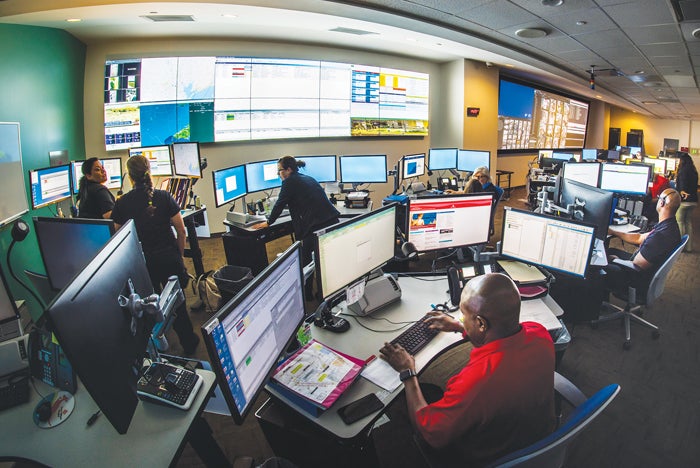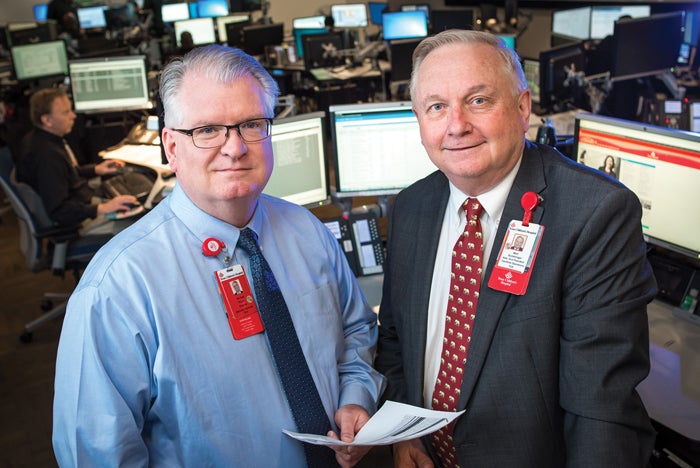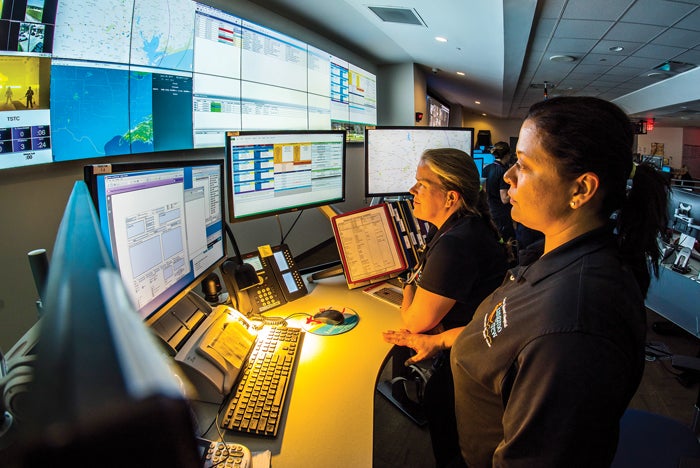Texas Children's Mission Control manages real-time patient movement

The Mission Control hub brings together security, facilities, code response, critical care admissions, hospital-to-hospital transfers, critical clinical alarm monitoring and room management operations.
Hurricane Harvey hit Houston last fall with torrential rains and unprecedented flooding. Much of the city saw 30 to 40 inches of rain pour over four days, inundating more than 100,000 homes and businesses.
Faced with such an immense catastrophe, Texas Children’s Hospital easily could have been overwhelmed. Located in Houston, the largest children’s hospital in the United States is a world unto itself. Its 14,000 employees are stationed across three hospital campuses and dozens of smaller locations — 6 million square feet in total.
For an entire week in August 2017, Hurricane Harvey forced Texas Children’s to contend with one crisis after another:
- The never-ending deluge of rain led to water intrusion in a number of buildings that had never seen water intrusion before. That necessitated the movement of patients.
- A partner hospital had a shortage of neonatal intensive care unit (NICU) nurses who could make their way to work, forcing that hospital to transfer NICU patients to Texas Children’s.
- Some of the streets leading to Texas Children’s became completely submerged, forcing the hospital’s “Kangaroo Crew” ambulances to be rerouted through constantly changing detours.
- Renal dialysis patients — children suffering from kidney failure — were having trouble getting to the hospital for their outpatient dialysis, which was absolutely necessary for their health. Some needed to be airlifted out of their homes.
State-of-the-art center
Fortunately for Texas Children’s, it is equipped with a secret weapon that enabled it to handle all of these emergencies. It’s a state-of-the-art nerve center called Mission Control.
Completed just a few months before the hurricane struck, Mission Control is a 3,500-square-foot nest of computer monitors and digital displays. It’s aptly named, because it looks like the kind of high-tech command center that NASA would use to launch rockets and space shuttles.
This unified operations center brings together security, facilities, code response, critical care admissions, hospital-to-hospital transfers, critical clinical alarm monitoring and room management. It has helped Texas Children’s Hospital to reduce transportation times, improve the patient-acceptance process, optimize system communications — and deal with crises like the wettest hurricane on record.
For successfully merging all of those functions, Mission Control was recognized late last year by the American Society for Healthcare Engineering (ASHE) when Texas Children’s Hospital received ASHE’s 2017 Excellence in Health Care Facility Management Award, sponsored by Trane.
The award’s judges were impressed with the innovative way that Mission Control brought together so many of the hospital’s disparate operations, says one of the judges, Wayne Klingelsmith, an ASHE past president and chairman of the ASHE Recognition Task Force.
“It greatly reduced patient transportation times and improved patient and physician satisfaction by making the emergency transfer and admissions process much easier,” Klingelsmith says. “The control room has a screen where real-time information on admissions/discharges, locations of ambulances, status of helipads, weather and road conditions and other critical information allows quick decisions, ensuring immediate corrective actions to expedite patient flow.”
He adds, “Their system takes the Code Blue notification from the telephone operators, who have no way of knowing the status of follow-up activity, and gives it to Mission Control, where response can be monitored, right down to the clinical alarm and elevator used for the response team and any needed patient transport.”
Knocking down silos
At Texas Children’s, this all started with a discussion between the facilities operations and security services departments back in 2008. These two departments operated independent service centers that often duplicated efforts, caused delays in responding to critical events, and created unnecessary confusion for patients and their families.
The two departments decided to combine their service centers. The result was launched in 2011. It integrated the core facilities services and security functions under one umbrella, leveraging people, processes and technology.
That was an important step forward. But it was just the first step, it turned out.
Shortly after the new combined service center launched, it became apparent to the Texas Children’s leadership team that the hospital could leverage this concept to improve the coordination of several other key clinical processes.
They put together a multidisciplinary team that included representatives from executive leadership, nursing, critical care, facilities management, facilities planning and development, information services and security services.
“Many of the departments that we were about to bring together tended to function within their own world — their own silo,” recalls Bert Gumeringer, the hospital’s vice president for facilities engineering and support services. “But we have a very collaborative culture here. We’re not above sharing good ideas with each other.”
Given a mandate, the hospital’s multidisciplinary team worked together to solve several key challenges facing the organization by:
- Effectively managing movement of patients across the system;
- Providing early clinical involvement in the patient-transfer process;
- Dispatching and monitoring ambulances and aircraft;
- Coordinating responses to trauma codes and calls for rapid-response teams;
- Addressing facilities and communications issues.
The end result involved everyone from security guards and code dispatchers to Houston Fire Department paramedics, Kangaroo Crew ambulance personnel, and physicians triaging patients when they first come into the hospital.
That’s a lot of moving parts to keep track of. One thing holds it all together:
“At the center of all this is the patient,” Gumeringer says. “The patient is our focus.”
Simplified and streamlined
The $1.285 million Mission Control project, completed in April 2017, does a lot of things. But its single biggest impact is this: It has dramatically changed how Texas Children’s Hospital admits patients.

Michael Hogan (left), director of security services, and Bert Gumeringer, vice president for facilities engineering and support services, in Mission Control.
“We used to have over 600 people involved in scheduling appointments, at about 100 locations and access points, in 18 departments with different processes,” Gumeringer says. “In health care, that’s pretty normal. Our CEO, Mark Wallace, would say, ‘This is not just a problem in health care. This is THE problem in health care.’”
Now the process is simplified and streamlined. “In Mission Control, there’s a dashboard that shows every available bed in the system,” Gumeringer says. “Before, that information used to be held on a spreadsheet. You’d have to physically call the house supervisor and see about a room assignment.”
Michael Hogan, director of security services, was a member of the multidisciplinary team that mapped out the creation of Mission Control. He recalls working in the command center shortly after its debut and witnessing an example of how these dramatic changes played out.
Texas Children’s encompasses three different hospital campuses — Texas Medical Center, the West Campus and the Woodlands. On this particular occasion, a patient needed to be transferred to the West Campus center.
“One of the folks in the room said, ‘We need the number to the West Campus security office.’ She had a question for security about an issue with a patient transfer. She thought she needed to call someone at this physical facility 30 miles away,” Hogan recalls. “But it turned out she could just walk across the room and talk to someone right there.”
He adds, “You could kind of see the shift in her mind. She was like, ‘Wow, we’re sitting in the same room together, working on the same problem.’ She got what she needed, and we saved her three steps.”
Now, take that one small interaction, and scale it up to a 745-bed hospital system that admits more than 30,000 patients and handles 122,000 emergency department visits per year. “All these different functions used to be in different parts of the hospital,” Gumeringer says. “There was a lot of time lost just trying to contact people.”
Real-time data
Now that Mission Control is the operations hub for the patient admissions and transfer system, its staffers rely on real-time data to make decisions. Each of its workstations has four monitors that display information vital to the patient-transfer process.
A huge LED display at the front of the room shows a list of patient admissions and discharges from Texas Children’s, the location of all Texas Children’s ambulances, both of the organization’s helipads and hospital census data.
The clinical side of the operations center uses dashboards to view information related to:
- Patient census for emergency department, acute care and clinical care beds;
- Transport status;
- Weather and road conditions;
- National news;
- Aircraft and helistops;
- Call volumes;
- Code response.
- Meanwhile, the facility/security side of the center uses similar dashboards to monitor:
- Closed-circuit TV cameras across the hospital system;
- Security call volumes;
- Elevator operations;
- Building automation alarms and status;
- Work-order planning and management.
‘A big difference’
When it comes to streamlining patient transfers, Mission Control started producing results immediately. During its first month of operation, the transfer team reduced its time from dispatch to pickup by 20 minutes. Cutting down the response time has led to a significant increase in transports. There were 151 transports in May 2017, representing a 20 percent increase month-to-month.
The importance of real-time information is dramatically illustrated when pediatric patients are flown to the hospital from Texas and around the country.
In the days before Mission Control, those airplane transports were an inefficient and unwieldy process. “You’d be getting all the pieces together, scheduling the aircraft and trying to track down the right receiving doctor,” Hogan recalls. “If you’re the patient, you’d get off the plane, check into the hospital, and be triaged in the emergency care (EC) exam room while we try to find you a bed upstairs. You might board for six to eight hours in EC until we’re ready for you.”
Today, staffers in Mission Control can track the aircraft on a screen as it crosses Texas. They can even see if a storm front is threatening to delay it. When the plane touches down in Houston, an ambulance is pre-positioned to whisk a patient to Texas Children’s, where a hospital room or a surgical suite awaits him or her.
“That all would have happened with cellphones in the past, and it would not have been as well-coordinated and orchestrated,” Gumeringer says. “We get patients into the facility much quicker. They may need emergency surgery, and a minute here or a minute there can make a big difference in their clinical outcome.”
Mike Brassfield is a freelance writer based in St. Petersburg, Fla.
About the project
- Project: Mission Control
- Facility: Texas Children’s Hospital
- Start date: February 2016
- Completion date: April 2017
- Budget: $1.4 million
- Actual cost: $1.285 million
Project team
- Bert Gumeringer, vice president for facilities engineering and support services
- Gail Parazynski, assistant vice president of nursing
- Mona McPherson, M.D., associate professor, intensive care
- Jeanine Graf, M.D., associate professor, intensive care
- Deborah D’Ambrosio, director of transport/nerve center
- Michael Hogan, director of security services





